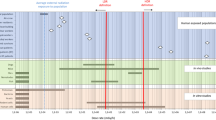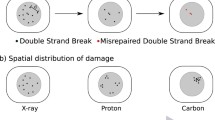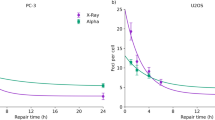Abstract
Ionizing radiation primarily perturbs the basic molecular level proportional to dose, with potential damage propagation to higher levels: cells, tissues, organs, and whole body. There are three types of defenses against damage propagation. These operate deterministically and below a certain impact threshold there is no propagation. Physical static defenses precede metabolic-dynamic defenses acting immediately: scavenging of toxins;—molecular repair, especially of DNA;—removal of damaged cells either by apoptosis, necrosis, phagocytosis, cell differentiation-senescence, or by immune responses,—followed by replacement of lost elements. Another metabolic-dynamic defense arises delayed by up-regulating immediately operating defense mechanisms. Some of these adaptive protections may last beyond a year and all create temporary protection against renewed potentially toxic impacts also from nonradiogenic endogenous sources. Adaptive protections have a maximum after single tissue absorbed doses around 100–200 mSv and disappear with higher doses. Low dose-rates initiate maximum protection likely at lower cell doses delivered repetitively at certain time intervals. Adaptive protection preventing only about 2–3 % of endogenous lifetime cancer risk would fully balance a calculated-induced cancer risk at about 100 mSv, in agreement with epidemiological data and concordant with an hormetic effect. Low-dose-risk modeling must recognize up-regulation of protection.
This work represents the opinion of its authors. It should not be read as representing the position of the NIH, DHHS, nor the US Government.
This chapter corresponds to a paper published by Dose-Response in June 2010 and is given here by permission from the journal Dose-Response.
Access this chapter
Tax calculation will be finalised at checkout
Purchases are for personal use only
Similar content being viewed by others
References
Azzam EI, de Toledo SM, Raaphorst GP, Mitchel REJ (1996) Low-dose ionizing radiation decreases the frequency of neoplastic transformation to a level below the spontaneous rate in C3H 10T1/2 cells. Radiat Res 146:369–373
Barcellos-Hoff MH, Brooks AL (2001) Extracellular signaling through the microenvironment: a hypothesis relating carcinogenesis; bystander effects, and genomic instability. Radiat Res 156:618–627
Bond VP, Fiedner TM, Archambeau JO (1966) Mammalian Radiation Lethality: a Disturbance in Cellular Kinetics. Academic Press, New York
Bond VP, Benary V, Sondhaus CA, Feinendegen LE (1995) The meaning of linear dose-response relations, made evident by use of absorbed dose to the cell. Health Phys 68:786–792
Brenner DJ, Hall EJ (2007) Computed tomography–an increasing source of radiation exposure. N Engl J Med 357:2277–2284
Calabrese EJ, Baldwin LA (2003) Toxicology rethinks its central belief. Nature 421:691–692
Cardis E et al (2007) The 15-country collaborative study of cancer risk among radiation workers in the nuclear workers in the nuclear industry: estimates of radiation-related cancer risks. Radiat Res 167:396–416
Chandra J, Samali A, Orrenius S (2000) Triggering and modulation of apoptosis by oxidative stress. Free Radic Biol Med 29:323–333
Day TK, Zeng G, Hooker AM, Bhat M, Scott BR, Turner DR, Sykes PJ (2006) Extremely low priming doses of X radiation induce an adaptive response for chromosomal inversions in pKZ1 mouse prostate. Radiat Res 166:757–766
Dziegielewski J, Baulch JE, Goetz W, Coleman MC, Spitz DR, Murley JS, Grdina DJ, Morgan WF (2008) WR-1065, the active metabolite of amifostine, mitigates radiation-induced delayed genomic instability. Free Radic Biol Med 45:1674–1681
Elmore E, Lao X-Y, Kapadia R, Redpath JL (2009) Threshold-type dose response for induction of neoplastic transformation by 1 GeV/nucleon iron ions. Radiat Res 171:764–770
Feinendegen LE (2002) Reactive oxygen species in cell responses to toxic agents. Hum Exp Toxicol 21:85–90
Feinendegen LE (2005) Evidence for beneficial low level radiation effects and radiation hormesis. Brit J Radiol 78:3–7
Feinendegen LE, Neumann RD (2005) Physics must join with biology in better assessing risk from low-dose irradiation. Rad Prot Dosim 117:346–356
Feinendegen LE, Muehlensiepen H, Lindberg C, Marx J, Porschen W, Booz J (1984) Acute and temporary inhibition of thymidine kinase in mouse bone marrow cells after low-dose exposure. Intern J Radiat Biol 45:205–215
Feinendegen LE, Loken MK, Booz J, Muehlensiepen H, Sondhaus CA, Bond VP (1995) Cellular mechanisms of protection and repair induced by radiation exposure and their consequences for cell system responses. Stem Cells 13(1):7–20
Feinendegen LE, Bond VP, Sondhaus CA, Muehlensiepen H (1996) Radiation effects induced by low doses in complex tissue and their relation to cellular adaptive responses. Mutat Res 358:199–205
Feinendegen LE, Bond VP, Sondhaus CA, Altman KI (1999) Cellular signal adaptation with damage control at low doses versus the predominance of DNA damage at high doses. C.R Acad Sci Paris, Life Sciences 322:245–251
Feinendegen LE, Neumann RD (eds) (2000) Cellular responses to low doses of ionizing radiation. Workshop of the US department of energy (DOE), Washington, and the national institutes of health (NIH), Bethesda, held on 27–30 April 1999 at the Mary Woodward Lasker Center, Cloister, NIH DOE Report Publication SC-047
Feinendegen LE, Bond VP, and Sondhaus CA (2000) The dual response to low-dose irradiation: induction versus prevention of DNA damage. In: Yamada T, Mothersill C, Michael BD, Potten CS (eds), Biological effects of low dose radiation, Excerpta Medica, International Congress Serie 1211. Elsevier, Amsterdam pp 3–17
Feinendegen LE, Pollycove M, Sondhaus CA (2004) Responses to low doses of ionizing radiation in biological systems. Nonlinearity in Biol Toxicol Med 2:143–171
Feinendegen LE, Pollycove M, Neumann RD (2007a) Whole body responses to low-level radiation exposure: new concepts in mammalian radiobiology. Exp Hematol 35:37–46
Feinendegen LE, Paretzke HG, Neumann RD (2007b) Damage propagation in complex biological systems following exposure to low doses of ionizing radiation. AFP: Int J 1:336–354
Feinendegen LE, Paretzke HG, Neumann RD (2008) Response to Comments by Dr. de Saint Georges: damage propagation in complex biological systems following exposure to low doses of ionizing radiation. AFP: Int J 2:206–210
Feinendegen LE, Brooks AL, Morgan WF (2011) Biological consequences and health risks of low-level exposure to ionizing radiation: commentary on the workshop. Health Phys 100:247–259
Finkel T, Holbrook NJ (2000) Oxidants, oxidative stress and the biology of aging. Nature 408:239–247
Fliedner TN, Dörr H, Meineke V (2005) Multi-organ involvement as a pathogenic principle of the radiation syndromes: a study involving 110 case histories documented in SEARCH and classified as the bases of haematopoetic indicators of effect. Brit J Radiol Suppl 27:1–8
Franco N, Lamartine J, Frouin V, Le Minter P, Petat C, Leplat JJ, Libert F, Gidrol X, Martin MT (2005) Low-dose exposure to gamma rays induces specific gene regulations in normal human keratinocytes. Radiat Res 163:623–635
Fujita K, Ohtomi M, Ohyama H, and Yamada T (1998) Biphasic induction of apoptosis in the spleen after fractionated exposure of mice to very low doses of ionizing g radiation. In: Yamada T, Hashimoto Y (eds), Apoptosis, its role and mechanism, Business Center for Academic Societies Japan, Tokyo, pp 201–218
Guyton AC, Hall JE (2005) Textbook of medical physiology, 11th edn. WB Saunders Company, Philadelphia
Hall EJ, Giaccia AJ (2005) Radiobiology for the Radiologist, 6th edn. Lippincott Williams & Wilkins, New York
Harder D (2008) Ionisierende Strahlung and die Dosiabhängigkeit ihrer Wirkung. Nova Acta Leopoldina NF 96(355):21–44
Heidenreich WF, Hoogenweem R (2001) Limits of applicability for the deterministic approximation of the two-step cloncal expansion model. Risk Anal 21:103–105
Heidenreich WF, Paretzke HG, Jacob P (1997) No evidence for increased tumour rates below 200 mSv in atomic bomb survivors. Radiat Environ Biophys 36(3):205–207
Hohn-el-Karim K, Muehlensiepen H, Altman KI, Feinendegen LE (1990) Modification of effects of radiation on thymidine kinase. Intern J Radiat Biol 58:97–110
ICRP (International Commission on Radiation Protection) (1977) Recommendations of the international commission on radiological protection, ICRP Publication 26, Annals of the ICRP 1 No. 3
ICRU (International Commission on Radiation Units and Measurements) (1983) Microdosimetry. Report 36, ICRU, Bethesda
ICRU (International Commission on Radiation Units and Measurements) (2005) Patient dosimetry of X-rays used in medical imaging, Report 74, J ICRU; Oxford J, Oxford University Press, Oxford
ICRU (International Commission on Radiation Units and Measurements) (2011) Quantification and reporting of low-dose and other heterogeneous exposures. Report 86, J ICRU; Oxford University Press, Oxford
ICRU (Internationalö Comnission on Radiaiton Units and Measurements) (1998) Fundamental quanititis and units for ionizting radiaiton, report 60. ICRU, Bethesda
ICRU (International Commission on Radiation Units and Measurements) (2002) Acsorbed dose specification in nuclerar medicine, Report 67, J thw ICRU; Oxford J, Oxford University Press, Oxford
Ishizaki K, Hayashi Y, Nakamura H, Yasui Y, Komatsu K, Tachibana A (2004) No induction of p53 phosphorylation and few focus formation of phosphorylated H2AX suggest efficient repair of DNA damage during chronic low-dose-rate irradiation in human cells. J Radiat Res 45:521–525
James SJ, Makinodan T (1990) T-cell potentiation by low dose ionizing radiation: possible mechanisms. Health Phys 59:29–34
Kadhim MA, Hill MA, Moore SR (2006) Genomic instability and the role of radiation quality. Radiat Prot Dosimetry 122:221–227
Kondo S (1988) Altruistic cell suicide in relation to radiation hormesis. Intern J Radiat Biol 53:95–102
Leonard BE (2007) Adaptive response and human benefit: Part I—a microdosimetric dose dependent model. Intern J Radiat Biol 83:115–131
Liu SZ, Zhang YC, Mu Y, Su X, Liu JX (1996) Thymocyte apoptosis in response to low-dose radiation. Mutat Res 358:185–191
Mitchel REJ, Jackson JS, Morrison DP, Carlisle SM (2003) Low doses of radiation increase the latency of spontaneous lymphomas and spinal osteosarcomas in cancer prone, radiation sensitive Trp53 heterozygous mice. Radiat Res 159:320–327
Mitchel RE, Burchart P, Wyatt H (2008) A lower dose threshold for the in vivo protective adaptive response to radiation. Tumorigenesis in chronically exposed normal and Trp53 heterozygous C57BL/6 mice. Radiat Res 170:765–775
Morgan WF, Sowa MB (2009) Non-targeted effects of ionizing radiation: Implications for risk assessment and the radiation dose response profile. Health Phys 97:426–432
Mothersill C, Seymour CB (2006) Radiation-induced bystander effects and the DNA paradigm: an “out of field” perspective. Mutat Res 59:5–10
Mullenders L, Atkinson M, Paretzke H, Sabatier L, Bouffler S (2009) Assessing cancer risk of low-dose radiation. Nat Rev/Cancer 9:596–604
Nair RR, Rajan B, Akiba S, Jayalekshmi P, Nair MK, Gangadharan P, Koga T, Morishima H, Nakamura S, Sugahara T (2009) Background radiation and cancer incidence in Kerala, India-Karanagappally cohort study. Health Phys 96:55–66
National Research Council, Committee to Assess Health Risks from Exposure to Low Levels of Ionizing Radiation (2006) Health risks from low levels of ionizing radiation: BEIR VII, Phase 2. The National Academies Press, Washington
Neumaier T, Swenson J, Pham C, Polyzos A, Lo AT, Yang PA, Dyball J, Asaithamby A, Chen DJ, Bissell MJ, Thalhammer S, Costes SV (2012) Evidence for formation of DNA repair centers and dose-response nonlinearity in human cells. Proc Nat Acad Sci US 109:443–448
Nikjoo H, O’Neill P, Terrissol M, Goodhead DT (1999) Quantitative modelling of DNA damage using Monte-Carlo track structure method. Radiat Envrion Biophys 38:31–38
Olivieri G, Bodycote J, Wolff S (1984) Adaptive response of human lymphocytes to low concentration of radioactive thymidine. Science 223:594–597
Pollycove M, Feinendegen LE (2001) Biologic response to low doses of ionizing radiation: detriment versus hormesis. Part 2: dose responses of organisms. J Nucl Med 42:26N–32N
Pollycove M, Feinendegen LE (2003) Radiation-induced versus endogenous DNA damage: possible effect of inducible protective responses in mitigating endogenous damage. Hum Exp Toxicol 22:290–306
Preston DL, Pierce DA, Shimizu Y, Cullings HM, Fujita S, Funamoto S, Kodama K (2004) Effect of recent changes in atomic bomb survivor dosimetry on cancer mortality risk estimates. Radiat Res 162:377–389
Preston DL, Ron E, Tokuoka S, Funamoto S, Nishi N, Soda M, Mabuchi K, Kodama K (2007) Solid cancer incidence in atomic bomb survivors: 1958–1998. Radiat Res 168:1–64
Rothkamm K, Löbrich M (2003) Evidence for a lack of DNA double-strand break repair in human cells exposed to very low x-ray doses’. Proc Natl Acad Sci US 100:5057–5062
Schöllnberger H, Stewart RD, Mitchel REJ (2005) Low-LET-induced radioprotective mechanisms within a stochastic two-stage cancer model. Dose-Response 3:508–518
Scott BR (2004) A biological-based model that.links genomic instability; bystander effects, and adaptive response. Mutat Res 568:129–143
Sedelnikova OA, Horikawa I, Zimonjic DB, Popescu NC, Bonner WM, Barrett JC (2004) Senescing human cells and ageing mice accumulate DNA lesions with unrepairable double-strand breaks. Nature Cell Biol 6:168–170
Sen K, Sies H, Baeurle P (eds) (2000) Redox regulation of gene expression. Academic Press, San Diego
Tanooka H (2001) Threshold dose-response in radiation carcinogenesis: an approach from chronic beta-irradiation experiments and a review of non-tumour doses. Int J Radiat Biol 77:541–551
Tanooka H (2011) Meta-analysis of non-tumour doses for radiation-induced cancer on the basis of dose-rate. Int J Radiat Biol 87:645–652
Tubiana M, Aurengo A, Averbeck D, et al. (2005). Dose-effect relationships and the estimation of the carcinogenic effects of low doses of ionizing radiation. Academy of Medicine (Paris) and Academy of Science (Paris) Joint Report No. 2
Tubiana M, Feinendegen LE, Yang CJM, Kaminski JM (2009) The linear no-threshold relationship is inconsistent with radiation biologic and experimental data. Radiology 251:13–22
Vilenchik MM, Knudson AG (2000) Inverse radiation dose-rate effects on somatic and germ-line mutations and DNA damage rates. Proc Natl Acad Sci US 97:5381–5386
Wolff S, Afzal V, Wienke JK, Olivieri G, Michaeli A (1988) Human lymphocytes exposed to low doses of ionizing radiations become refractory to high doses of radiation as well as to chemical mutagens that induce double-strand breaks in DNA. Intern J Radiat Biol 53:39–49
Zamboglou N, Porschen W, Muehlensiepen H, Booz J, Feinendegen LE (1981) Low dose effect of ionizing radiation on incorporation of iodo-deoxyuridine into bone marrow cells. Int J Radiat Biol 39:83–93
Author information
Authors and Affiliations
Corresponding author
Editor information
Editors and Affiliations
Rights and permissions
Copyright information
© 2012 Springer-Verlag Berlin Heidelberg
About this chapter
Cite this chapter
Feinendegen, L.E., Pollycove, M., Neumann, R.D. (2012). Hormesis by Low Dose Radiation Effects: Low-Dose Cancer Risk Modeling Must Recognize Up-Regulation of Protection. In: Baum, R. (eds) Therapeutic Nuclear Medicine. Medical Radiology(). Springer, Berlin, Heidelberg. https://doi.org/10.1007/174_2012_686
Download citation
DOI: https://doi.org/10.1007/174_2012_686
Published:
Publisher Name: Springer, Berlin, Heidelberg
Print ISBN: 978-3-540-36718-5
Online ISBN: 978-3-540-36719-2
eBook Packages: MedicineMedicine (R0)




